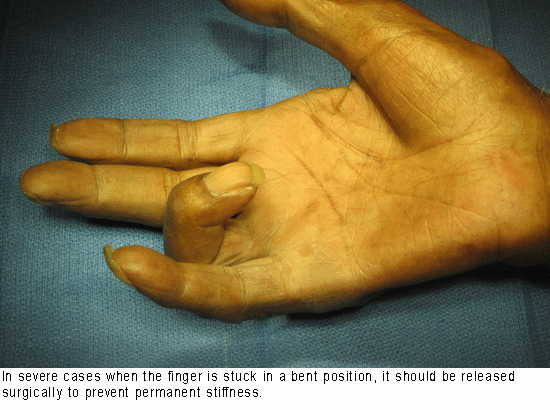Description
A trigger finger is a common problem that causes pain and catching. Tendons that help bend the fingers and thumb slide through a snug tunnel. Irritation as the tendons slip into the tunnel can cause the opening of the tunnel to become smaller, or the tendon to thicken so that it can’t easily pass through the tunnel.
As you try to straighten the finger, the tendon becomes momentarily stuck at the mouth of the tunnel then pops as the tendon slips past the tight area. This can cause pain and catching as you try to move the finger. Your doctor can diagnose the problem by talking with you and examining your hand. No X-rays or other testing are usually needed.
Risk Factors/Prevention
It isn’t usually known what causes the problem. Trigger fingers are more common in women than men. They occur most frequently in people who are between the ages of 40 to 60 years. Trigger fingers are more common in people with certain medical problems such as diabetes and rheumatoid arthritis.
Symptoms
Symptoms usually start without any injury. You may feel pain in the palm, sometimes along with swelling or a small lump. You may feel the catching or popping sensation in the finger or thumb joints. Stiffness and catching tend to be worse after inactivity, such as when you wake in the morning, but will often loosen up with movement. When it breaks free, it may feel like the finger joint is dislocating. In severe cases the finger may become stuck in a bent position so that it can’t be straightened even with the help of other fingers. One or more fingers can be involved.
Treatment Options
If your symptoms are mild, simply resting the finger may be enough to relieve the problem. Over-the-counter medications such as Tylenol® or Advil® can be used for pain. Splints are sometimes used to rest the finger. Your doctor may recommend an injection that helps in most cases, but sometimes the improvement is temporary. More than one injection may be needed. Injections are less likely to bring about permanent relief when the triggering has been present for a long time, or if you have associated medical problems like diabetes. If the problem remains troubling, you may want to consider surgery.

Treatment Options: Surgical
A trigger finger isn’t a dangerous condition, so the decision whether to proceed with surgery is a personal one based on the severity of your symptoms. If the finger is stuck in a bent position, surgery may be recommended to prevent permanent stiffness. Surgery widens the opening of the tunnel so the tendon can slide through more easily. This is usually done through a small incision in the palm as an outpatient surgery.
Sometimes the tunnel can be safely opened with the tip of a needle in your doctor’s office. You can move the fingers immediately after surgery. Elevating the hand after surgery can help minimize swelling and pain. Some soreness in the palm is common but recovery is usually complete in a few weeks. If the finger was quite stiff before surgery, a therapist may help you to loosen up the finger.
